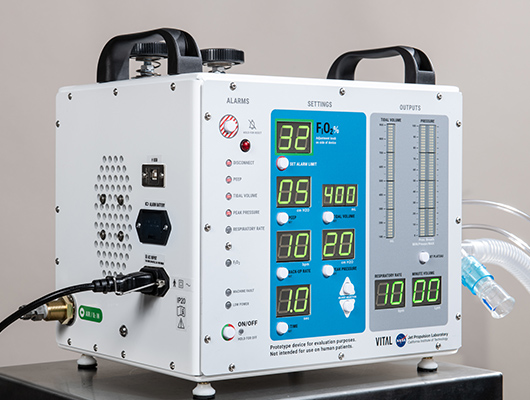Sensirion SDP31 flow sensor used in NASA’s high-pressure ventilator for coronavirus treatment

NASA has developed a high-pressure ventilator for the treatment of coronavirus patients and, together with the medical community, is fighting against the worldwide shortage of ventilators. The air flow from the device to the patient is measured by a Sensirion SDP31 flow sensor.
NASA’s Jet Propulsion Laboratory is helping the world with innovation, space technology and engineering. Within 37 days, engineers and others at the agency’s Jet Propulsion Laboratory in Southern California developed a high-pressure ventilation prototype tailored to the needs of patients with respiratory problems. The prototype has already been sent to the Icahn School of Medicine at Mount Sinai in New York for testing. The device is called VITAL (Ventilator Intervention Technology Accessible Locally) and is designed to be faster to build and easier to maintain than traditional ventilators, with a fraction of the number of parts. In the meantime, JPL has received an emergency use authorization for the new device from the FDA (Food and Drug Administration).
The NASA design relies on Sensirion’s SDP31 differential pressure sensor to monitor the inspiratory flow of air and oxygen. Sensirion’s differential pressure sensors are used in millions of sleep apnea therapy devices (known as CPAPs) around the world and are available in very large quantities. Fully calibrated flow sensor solutions from Sensirion are available in form of the SFM3xxx series, with the newly launched inspiratory flow meter SFM3019.
NASA’s development project has attracted worldwide attention. Recently, NASA Administrator Jim Bridenstine was even able to present some new NASA technologies that will help in the fight against coronavirus to the US President Donald Trump – including this new ventilator.
For more information, please visit http://www.sensirion.com.
News Categories
- » NEWS HOME
- » Automation & Robotics
- » Industry 4.0
- » Material Handling
- » Sensors
- » Quality & Testing
- » Machine Vision
- » Laser & Optics
- » Metalworking
- » Motion Control & Drives
- » Hydraulics & Pneumatics
- » Process Industry
- » Renewable Energy
- » Agriculture
- » Home & Office Furniture
- » Environmental Tech

